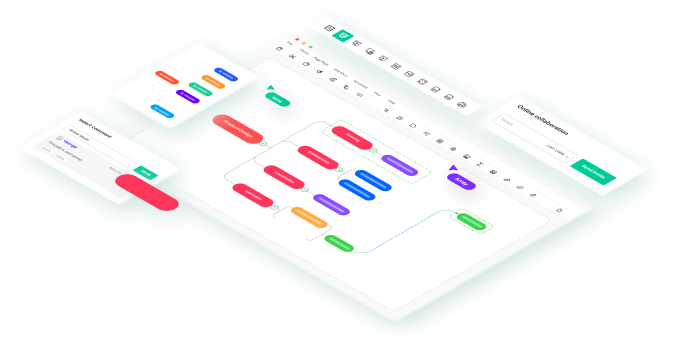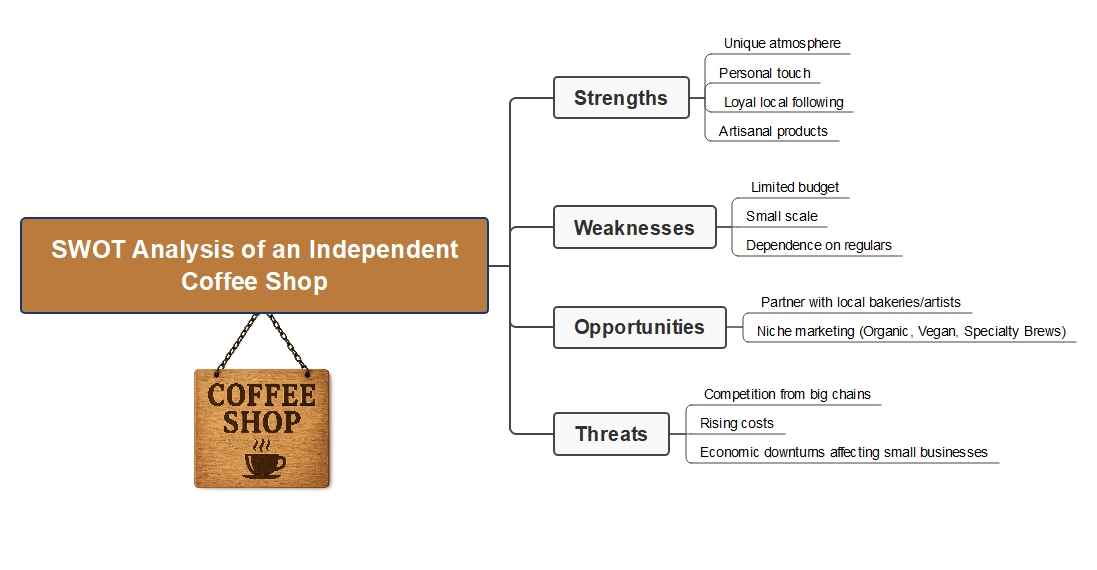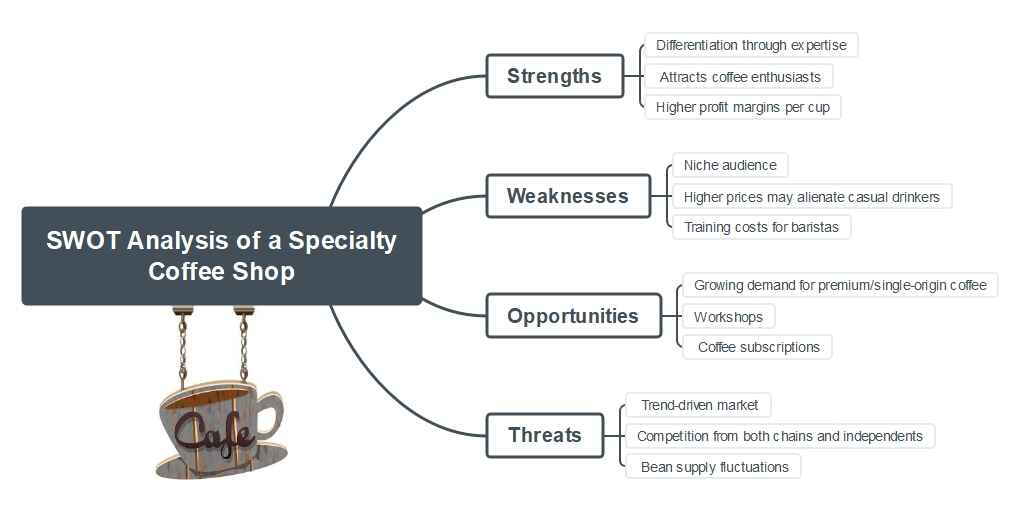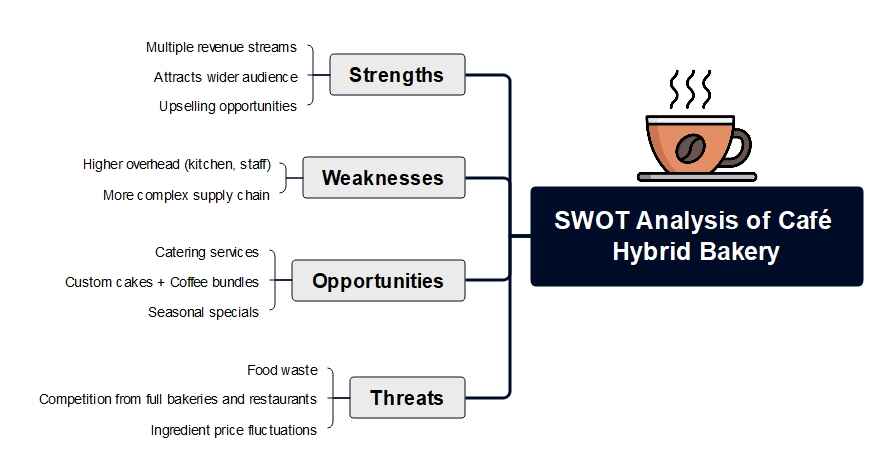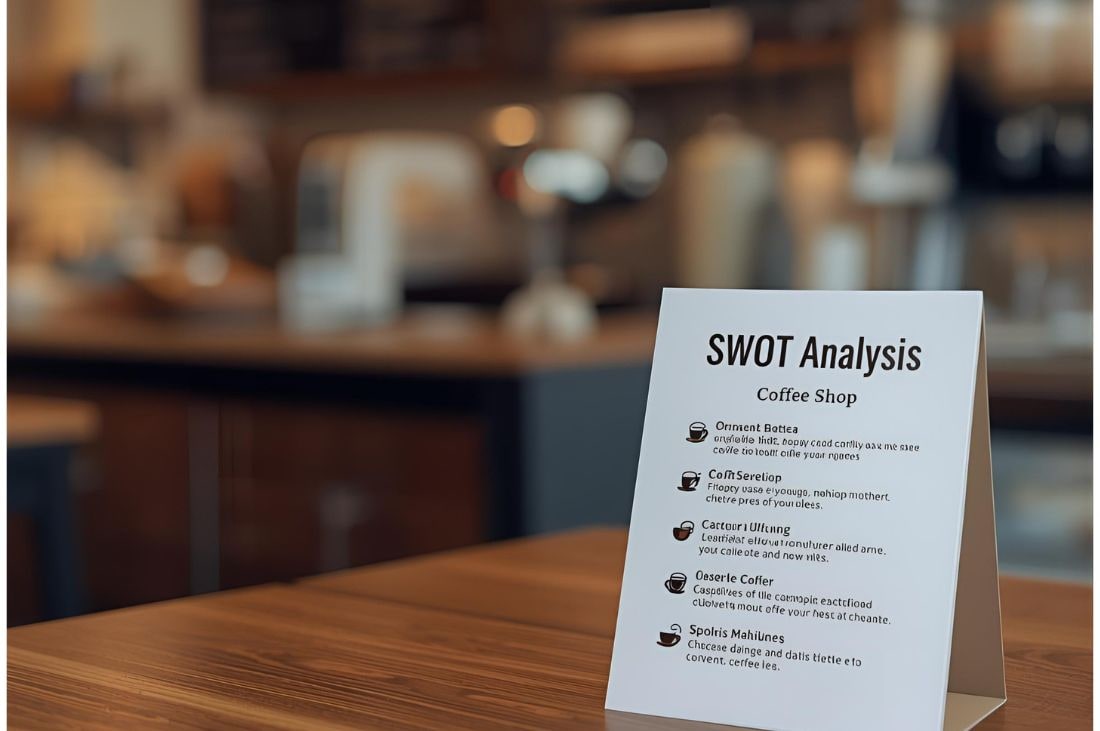
The coffee shop business is one of the most popular ventures in the world, and for good reason. Coffee isn’t just the second most traded commodity globally; it’s also a lifestyle choice. For many, coffee is a daily ritual and a social connector.
This makes opening a coffee shop a smart business move, but it also means there’s plenty of competition. From global franchises like Starbucks to local artisans, everyone’s serving up great coffee. So, how can you position your business more effectively in the market? That’s where a SWOT analysis for a coffee shop comes in.
Through this analysis, you can identify what’s already working for you and what needs improvement. It also reveals the roadblocks standing in your way. So, let’s take a deep dive into how to conduct a SWOT analysis for your café.
In this article
What is SWOT Analysis and How Does it Help?
A SWOT analysis is a data-driven review of a business through four key areas:
- Strengths
- Weaknesses
- Opportunities
- Threats
By analyzing these aspects, business owners can identify strategies that are more likely to succeed. The results help refocus the business on what works while avoiding strategies that have failed in the past. Here’s a quick look at all four components and how they help in strategic planning.
Strengths – These describe what a business excels at and what sets it apart from the competition. Strengths may include a great product, a strong brand image, a loyal customer base, or lucrative profit margins. Once identified, these can be leveraged to propel the brand even higher.
Weaknesses – These limit a business from performing at its optimal level. They represent areas that require improvement and constant attention. Weaknesses may include a weak brand image, low profit margins, outstanding debt, or inefficiencies in the supply chain. Understanding weaknesses enables a business to address them proactively.
Opportunities – These are external factors that can give a business a competitive edge. Opportunities may come in the form of new technology, delivery methods, product innovation, or emerging customer trends. By recognizing potential opportunities, business owners can act on them before competitors catch on.
Threats – These are external factors that can negatively impact business operations. For a coffee shop, threats may include rising material costs, supply chain disruptions, or new competitors in the vicinity. By spotting threats in advance, a business can set contingency plans in place to minimize their impact.
How to Conduct a SWOT Analysis for a Coffee Shop?
If you want to conduct a SWOT analysis for a cafe, here’s a complete guide to help you get started.
Strengths
Premium pricing
Some companies, such as Starbucks, charge premium pricing for coffee, and their customers are ready to pay for it. People wish to enjoy it due to its prestige, great service, and clean environment.
High-quality product/ service
A quality product or service includes various elements, such as delicious cuisine, a clean environment and utensils, and a cheerful attitude. All of these small acts add up to deliver a positive message.
Experience that is unique to you
When customers come to your café, you make an effort to engage with them on a personal level. It might be simple banter, a grin, a wink, a calm look, or anything else that makes consumers feel good. You may set yourself apart from the competition by providing a personalized experience.
The value of work
The labor values of coffee shops or cafés are rather obvious. It implies that you must be prompt and completely dedicated to the café and its clients. Customers appreciate you when you put your heart and soul into your business.
Weaknesses
The system is operated manually
Most coffee shops operate manually, which makes them prone to errors. This can lead to service delays and create challenges in scaling operations as demand increases.
Extremely competitive
When you build a coffee shop in a certain market, others can duplicate and produce a similar offering. Competitors might quickly enter the market, leaving you with little choice but to share profits with them.
Opportunities
New Techniques & Innovation
Staying ahead of the competition is all about continually upgrading your offerings. From introducing new flavors to experimenting with new brewing techniques, innovation is an opportunity you shouldn’t miss.
Product Line Expansion
Along with coffee, you can expand your product range by offering cookies, snacks, cakes, and other similar goods to your customers. It'll not only be a lovely addition to your goods, but it'll also bring in some extra cash.
Brand awareness through advertising
If you're starting a new franchise in a region, you may also utilize a sponsored social media ad technique to target a new market.
Mobile ordering and delivery platform
If your business is doing well, you might consider launching a mobile app to give your customers more delivery options. You could also offer a home delivery service directly through the app.
Threats
Profit margin may be low
Depending on the location, your coffee shop’s profits may fall short of expectations. Since income often comes in small amounts, once you’ve covered fixed costs and salaries, you may be left with only minimal profits.
Market with a high price sensitivity
Coffee is one of those products where you can't increase the price beyond a certain point. People would stop coming to your cafe for coffee if you did that because it was too pricey. You could soon be out of business.
Coffee Shop SWOT Analysis Examples
Not all coffee shops are the same; each type has its own vibe and business model. That’s why a SWOT analysis will differ depending on the type of coffee shop. Let’s explore the SWOT analyses of a few business models. These examples are created in EdrawMind, and you can download the templates to customize them for your own business.
Example 1: SWOT analysis of an Independent Coffee Shop
Independent coffee shops are small, individually owned businesses that focus heavily on community. They primarily cater to their neighborhood and serve as popular hangout spots with loyal customers. In this business model, the emphasis is on uniqueness and authenticity. While the target audience may be limited, independent coffee shops often enjoy a steady stream of regular customers once they’ve established their brand identity in the area.
Example 2. SWOT analysis for a drive-through or grab-and-go
Grab-and-go coffee shops are exactly what they sound like: a location where customers may get a fast cup of coffee or other drink, as well as food, and go about their business. Kiosks may be used as grab-and-go businesses. A modest coffee counter in a hotel or business building foyer is an example.
Example 3: SWOT analysis of a Specialty Coffee Shop
Specialty coffee shops are usually smaller setups compared to large chains. Their main offerings include high-quality beans, premium blends, and unique brewing methods. Think of them as a haven for true coffee enthusiasts. These shops focus on creating a distinctive customer experience that often turns visitors into loyal regulars. However, this elevated coffee experience typically comes with a premium price tag.
Example 4: SWOT analysis of a Coffee Shop Chain (Starbucks, Dunkin, Costa)
A coffee chain caters to a wider audience, with blends that vary based on regional preferences. These businesses prioritize consistency and brand recognition, ensuring that customers know exactly what to expect at any location. Many people choose coffee chains for their convenience and reliable quality.
Example 5: SWOT analysis of a Café Hybrid Bakery
These shops don’t just stop at coffee; they combine the coffee experience with freshly prepared items like cakes, cookies, brownies, and sandwiches. By offering more products, they appeal to a wider audience. Café-bakery hybrids are often the go-to choice for breakfast, brunch, or a quick snack.
How to Determine The Key Elements of SWOT Analysis for a Coffee Shop?
When you’re carrying out a SWOT analysis for a coffee shop, you need to factor in what makes it unique. Once you identify what type of coffee shop you’re analyzing, determining the 4 elements that drive a SWOT analysis becomes easier.
Here’s a brief guide to conducting a SWOT analysis for a coffee shop:
- Highlight and list your Strengths - Identify what makes your business a success. These are the things that you’re already good at and can become more beneficial if amplified. It could be your location, variety in beverages, or the friendly banter with customers.
- Identify your Weaknesses - Be honest about what’s really holding your business back and pinpoint your current challenges. Ask yourselves questions like: Is the pricing not competitive enough? Does the coffee taste good? Do people in the area know about your shop?
- Recognize Opportunities - Spot new market trends that can boost your growth. It could be a new brewing technique, introducing a popular flavor, launching a mobile app, offering delivery services to a wider area, or accommodating remote workers with a coffee/working area with Wi-Fi.
- Brainstorm Potential Threats - At this point, you should be able to anticipate external risks to your coffee business. Identify potential threats that can disrupt your operations or discourage customers from visiting your cafe. These threats can include new coffee shops in the vicinity, a hike in coffee bean prices, disruption in the supply chain, and so on.
Use a Professional SWOT Analysis Maker
The best way to create a SWOT analysis is by building a mind map. It helps organize your ideas and present them in an easily understandable way. The only catch is that you need to be a design expert to create a diagram like that.
The good news is, there’s an easier way to make a SWOT analysis diagram. Enter EdrawMind. This powerful diagramming tool comes with pre-built SWOT templates and lots of valuable customization features. The best part? You can find various templates, especially for the SWOT analysis of a coffee shop. So, all you need to do is pick one that you like and customize it according to your needs.
Steps to Make a SWOT Analysis Diagram
While there are plenty of templates to choose from, you can always start the SWOT analysis diagram from scratch. Here’s a step-by-step guide to help you create a SWOT analysis diagram of a coffee shop chain.
Step 1: Login & Get Started
- Open EdrawMind and log in with a social account or a free Wondershare account. You can also use EdrawMind Online through your browser.
- On the homepage, click Create, then select Local MindMap to open a blank canvas.
Tip: Use the online version to get started quickly.
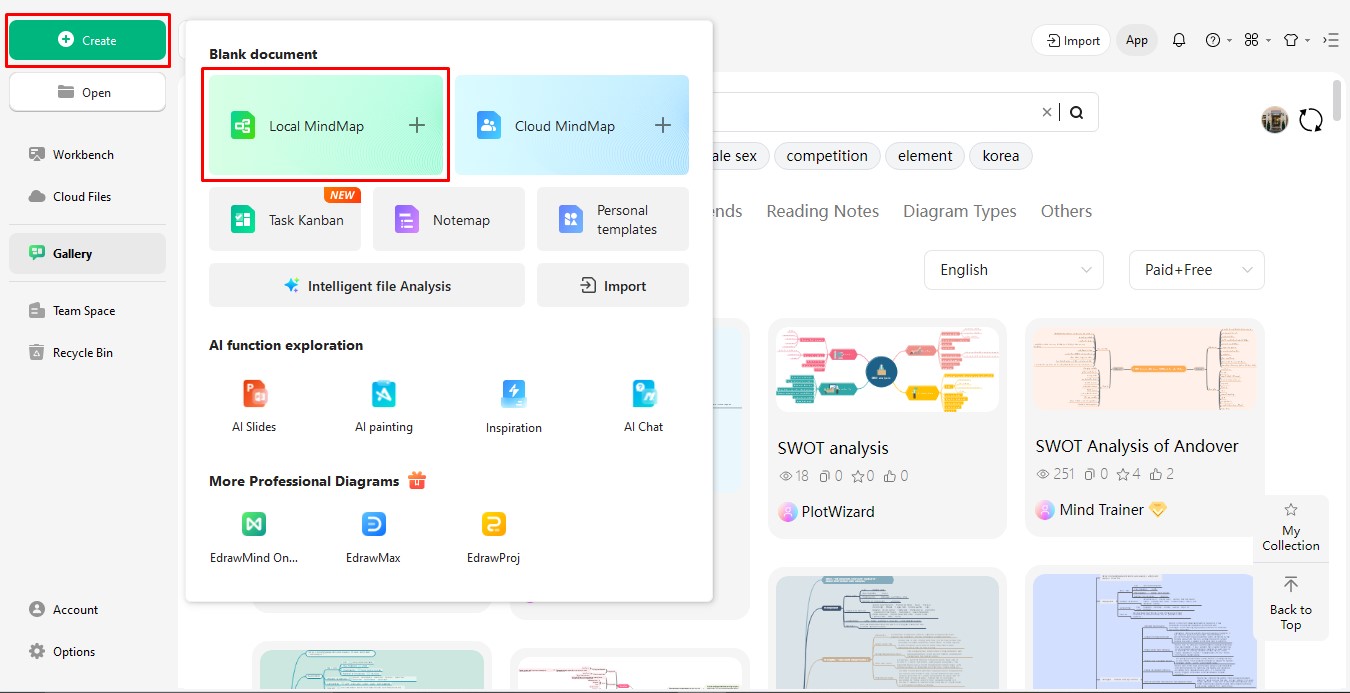
Step 2: Choose a Layout
- Click to reveal the right editing menu panel. Now, select the Main Idea and change the Layout from the menu.
- Alternatively, you can change the Layout by selecting the Main Idea and accessing the floating menu.
- Browse through the layouts and pick one that fits your analysis style.
Tip: You can also select a pre-built template and customize it to save time.
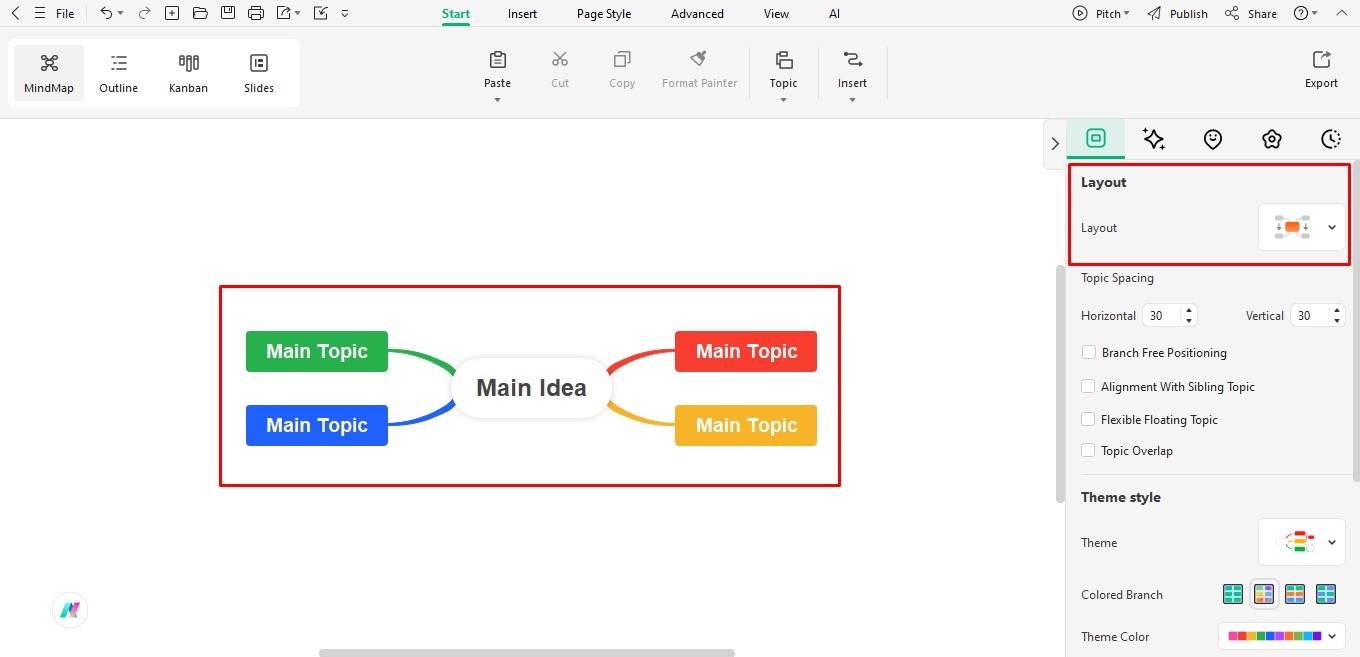
Step 3: Add Main Sections
- Let’s add main sections to the mindmap Click the Main Idea and change the text to ‘SWOT Analysis Of a Coffee Shop Chain.’
- Similarly, edit the text inside the key branches to Strengths, Weaknesses, Opportunities, and Threats
- EdrawMind allows you to customize your mind map in different ways. For example, you can change the shape, border color, and border size of every element. You can also fill color inside the text boxes to make them pop. You can either access these customization options through the floating menu. Or you can reveal the right editing panel to make these changes.
Tip: Don’t overcrowd the branches. Keep the text concise and focused.
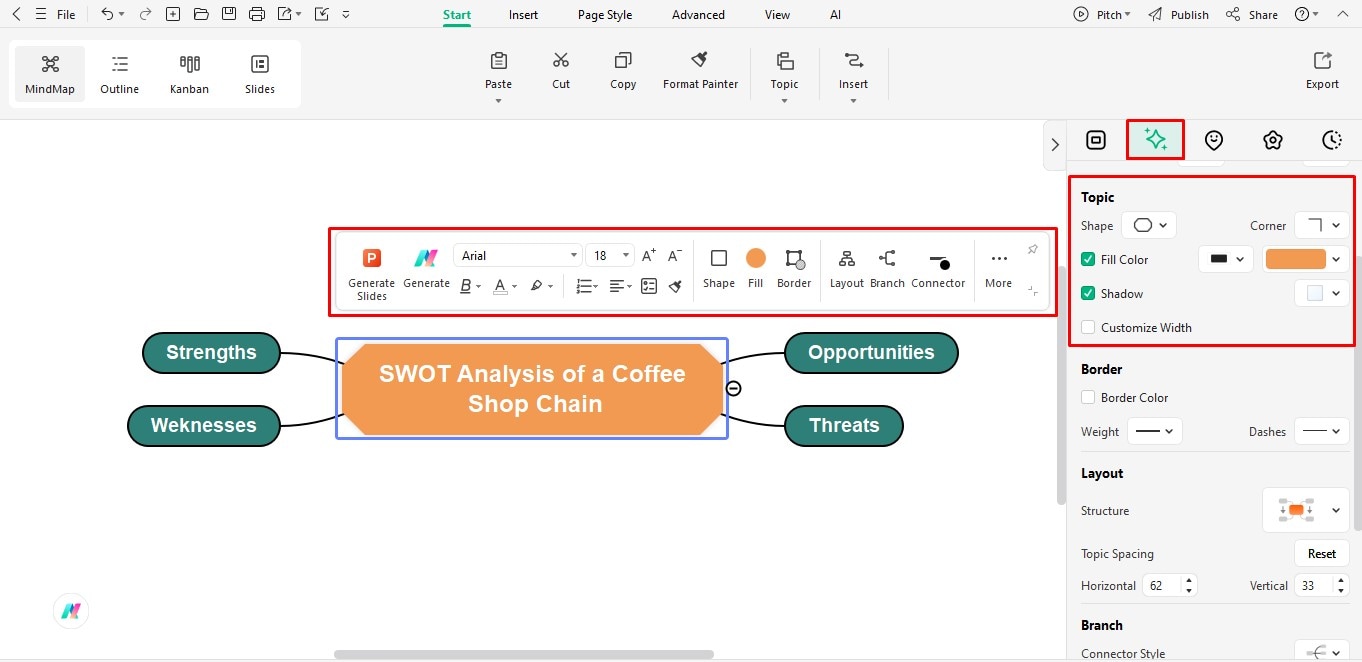
Step 4: Add Subtopics for Details
- Let’s expand each element for a detailed analysis. Click Strengths to reveal the floating menu. Select More > Subtopic to add a subtopic. Follow the same steps to add more subtopics.
- Do the same for Weaknesses, Opportunities, and Threats. You can edit the subtopic layout, its shape, border size, and color from the editing panel on the right.
Tip: Use short phrases instead of long sentences; it makes your map easy to read.
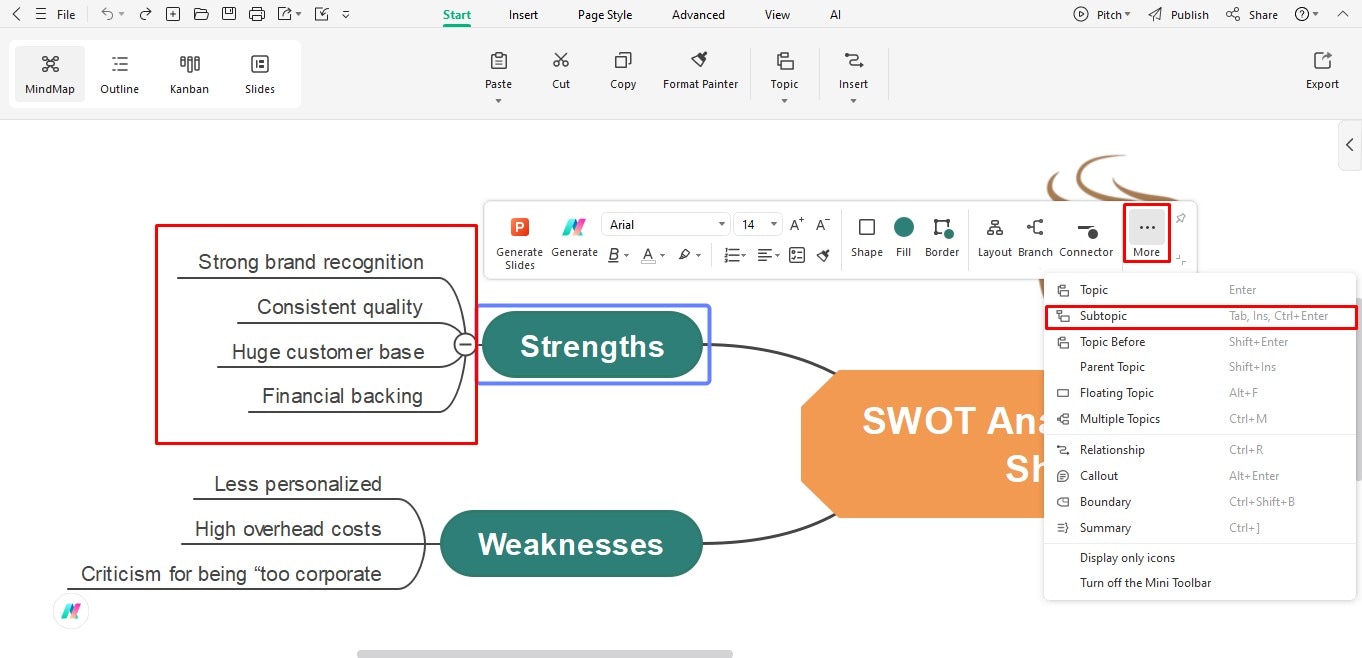
Step 5: Save or Share Your Analysis
Continue adding more subtopics until your analysis is complete. Once you’re satisfied with the analysis, click File in the top-left corner to view your saving options.
- Click Export to save your analysis in JPG, PNG, PDF, Word, Excel, HTML, or SVG format.
- If you want to collaborate with your team on the analysis, choose Share from the dropdown menu.
Tip: Exporting the analysis in PowerPoint format will help you create presentations quickly.
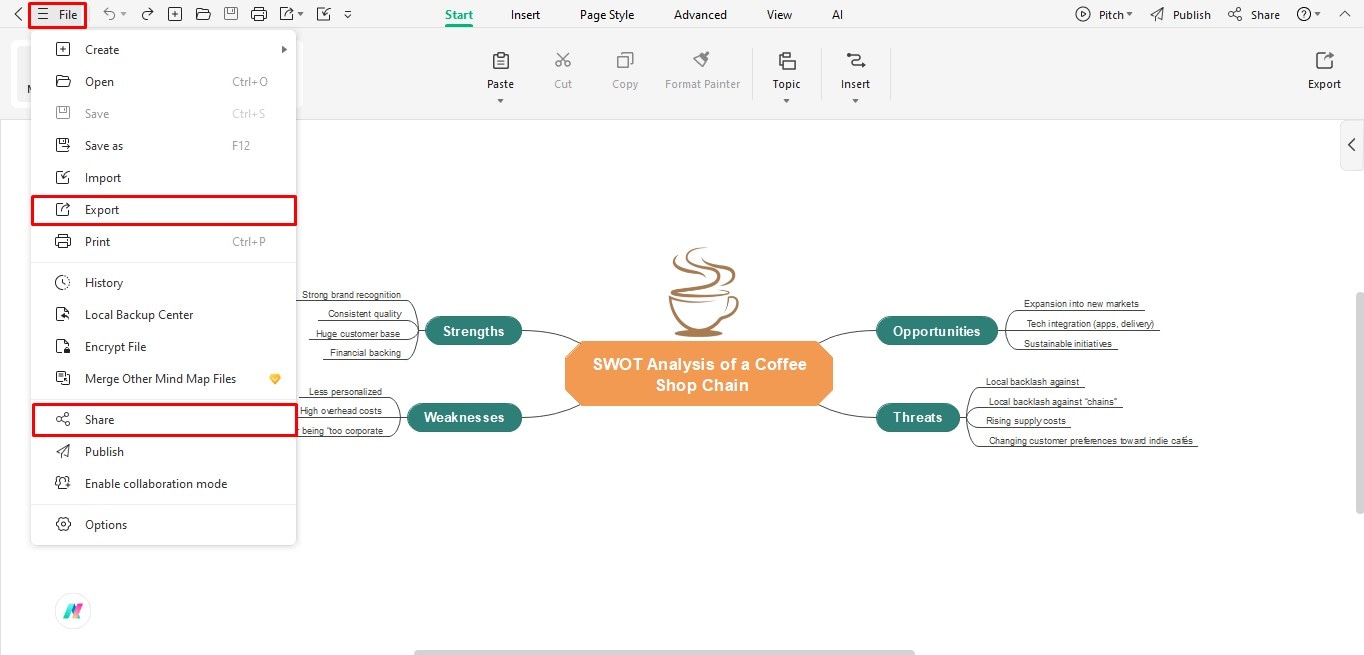
Tips to Make a Coffee Shop SWOT Analysis
Many businesses conduct SWOT analyses regularly. But if the process isn’t effective, it becomes a waste of time and effort. If you’re planning to assess your coffee shop through the SWOT lens, these tips will help you achieve tangible results.
Identify your goals and objectives
Before anything else, ask yourself what you want to achieve with this analysis. Are you trying to understand your business and market better? Or is your objective to improve your business model and grow sales? Knowing why you’re conducting a SWOT analysis and what you want to achieve by the end will make the whole process meaningful and result-oriented.
Brainstorm ideas
You might already have great ideas for your coffee shop, but they can be limited to your own imagination. That’s where extra brains come in handy. Sit with your team and discuss fresh ideas, opinions, and insights. A brainstorming session allows you to view your business from different perspectives and gain a clearer understanding of the four SWOT elements.
Analyse your competitors
The coffee industry is popular but also highly saturated. To get the most out of your SWOT analysis, it’s important to evaluate your competitors’ strengths and weaknesses regularly. By understanding the competition, you can sharpen your own strengths and spot opportunities in real time.
FAQs about SWOT Analysis of a Coffee Shop
-
What are the 4 elements of SWOT Analysis?
SWOT Analysis consists of these 4 elements: Strengths: These are things the business is already good at and what keep it ahead of competitors. Weaknesses: These are internal and external limitations of a business that deter it from reaching its full potential. Opportunities: They consist of chances that can benefit the business and propel its growth if seized at the right time. Threats: They are obstacles or external factors that can negatively impact the business. -
What are the strengths of a store?
Here are a few factors that can be classified as ‘strengths’ for a business: Location Pricing High repeat customers Brand recognition Premium quality products Product variety Excellent customer service -
What are the weaknesses of a cafe business?
Weaknesses of a cafe business may include: Low-quality coffee beans High operating costs Poor brand identity Unreliable supply chain Negative reputation in the community Lack of innovation in beverages Weak online presence -
What is the biggest problem in the coffee industry?
The biggest problem in the coffee industry is stiff competition. With multiple coffee shops and hybrid cafés in one area, maintaining steady foot traffic and healthy profit margins can be challenging. -
Is a coffee shop a good investment?
Yes, a coffee shop is a great investment because of the growing number of customers worldwide. Coffee culture is deeply rooted in younger generations, which means demand will continue to rise over time. However, several variables affect a coffee shop’s success, such as fluctuating material costs, high staff training expenses, and tough competition. In the end, success comes down to smart management and differentiation from the competition.
Key Takeaway
Conducting a SWOT analysis is a great way to assess your coffee shop. Remember, the purpose of this analysis is to build a business that is strong, reliable, transparent, and trustworthy. Ultimately, a SWOT analysis is about gaining fresh perspectives and uncovering new ideas.
If you’re planning to conduct a SWOT analysis for your coffee shop, try EdrawMind. The tool is beginner-friendly and delivers professional results with minimal effort.



